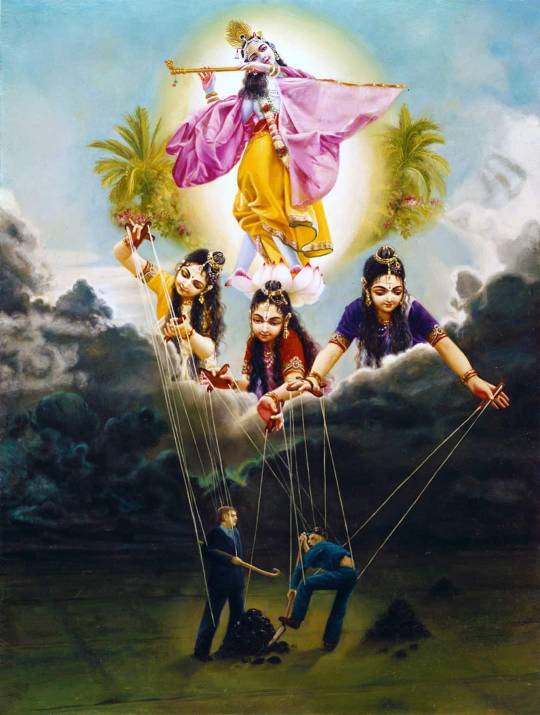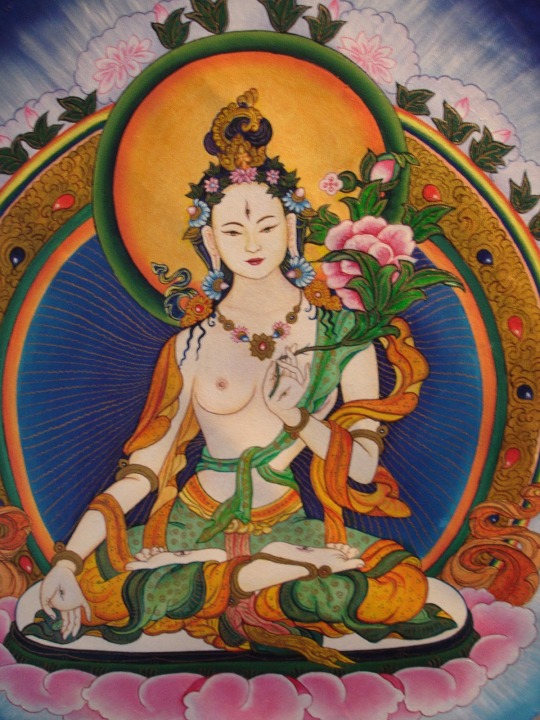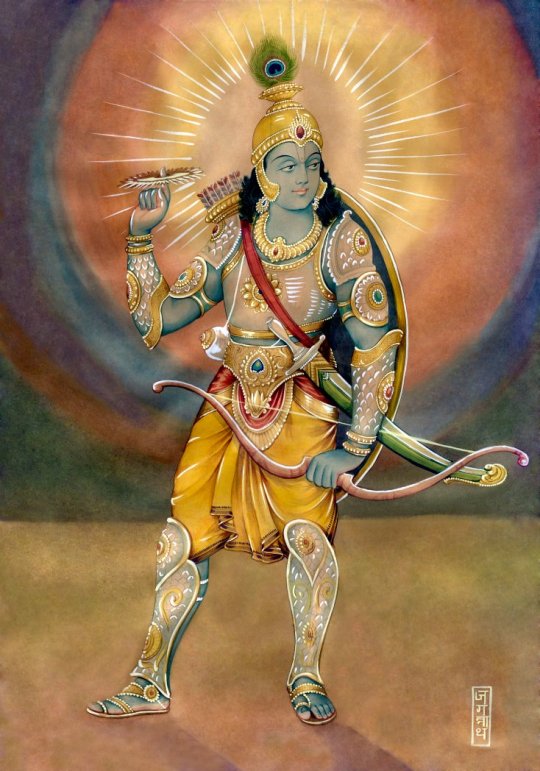#Bhakti yoga
Explore tagged Tumblr posts
Text

MATANGI
#shakti#mahavidya#tantra#hinduism#hindublr#bhakti#bhakti yoga#nonduality#nondualism#advaita vedanta#kali goddess#goddess kali#kali maa#mahadevi#mahakali#dark goddess#black goddess#dark mother#dark femenine
18 notes
·
View notes
Text
Just had the sudden realization that I'm probably going to be the only historical example of worshipping Vasanta in the distant future-
Like,, historians are gonna read the poem I just wrote about Vasanta omg-
14 notes
·
View notes
Video
youtube
Moods of Kirtan (Siksastakam)



Moods of Kirtan (Siksastakam) · As Kindred Spirits · Gaura Vani
#youtube#ISKCON#HARE KRISHNA#KRISHNA#KIRTAN#BHAJAN#HARINAM#DEVOTEES#DARSHAN#KRISHNA DARSHAN#BHAKTI YOGA#VEDIC#VISHNU#VAISHNAVA
6 notes
·
View notes
Text
The spirit soul bewildered by the influence of false ego thinks himself the doer of activities that are in actuality carried out by the three modes of material nature.
Bhagavad Gita As It Is 3.27

#dharma#dharmapunx#krishna#srilaprabhupada#bhakti#meditation#bhagavadgītā#hare krishna#bhakti yoga#mantra#againstthestream#truth seekers#spirituality
16 notes
·
View notes
Text
"My consciousness has never associated itself with this temporary body. Before I came on this earth, Father, I was the same. As a little girl, I was the same. I grew into womanhood, but still I was the same. When the family in which I had been born made arrangements to have this body married, I was the same... And, Father, in front of you now, I am the same. Ever afterward, though the dance of creation change around me in the hall of eternity, I shall be the same." -- Anandamayi Ma
37 notes
·
View notes
Text
4 notes
·
View notes
Text

“By Divine Grace, there comes a time in spiritual movement when an aspirant begins to feel the touch of Divine Presence in his life, a time when he gets his first real glimpse of Divine Love. This glimpse – these few dust particles from the Divine feet – cause bhava to come to life. No longer worldly, feeling soars away from the world into the realm of the transcendental.” (p. 83)
“… the ideal to be emulated by every aspirant: to remain balanced in pleasure and pain, gain and loss – in all pairs of opposites that characterize the vicissitudes of the world-process. While the mind of an ordinary individual is ever in turmoil during the diverse conditions of life, an aspirant must strive to hold his mind poised and calm at all times. Balance of mind is the secret of all prosperity, success and goodness. Many difficult conditions can be easily surmounted if one does not react in an irrational manner. When the mind is held in balance, one has the possibility of employing the correct self-effort in every difficult situation. Similarly, if the mind does not swing to swing to elation and become imbalanced during prosperity, much future sorrow can be avoided. It is through balance of mind that suffering is eliminated and the spirit triumphs over the world-process.
The precious secret of holding such a balanced mind is given by Saint Tulasidas in his prayer: Enshrine the enchanting face of Rama, the face of the Divine Self, in your consciousness. See it ever smiling in the depths of your heart – serene, full of bliss. Adversity and prosperity come and go like clouds, but that Divine Presence is ever unaffected. The perpetual awareness of that Divine face is the fertile soil in which saintliness grows, it is the promoter of all that is majestic and triumphant in the human spirit.” (p. 98-99)
“Sita especially portrays that aspect of devotion known as madhurya bhava, the sweet sentiment that a devotee holds for the Divine Self that is compared to the feelings of devoted wife towards her husband, or a lover to her beloved. Like Sita, the soul must be willing to tear itself away from all earthly comforts and attachments in order to truly love the Divine Self, who is the Supreme Lord, husband and beloved.” (p. 103)
“Love for Divinity has the power to bring new delight to the mind every day. The mind of a true devotee will never develop a sense of boredom. If, in pursuing japa (repetition of mantra) and devout meditation, an aspirant goes on asking himself ‚How long am I to continue doing these things?‘ then you must realize that he has not yet experienced true devotion. If there is true devotion, there will be increasing thrill and a sense of adventure. An aspirant is like a mountain climber, enduring the hardships of the steep climb because he eagerly looks forwards to reaching those greater and greater heights from which he can view a wider horizon of Divine Glory.” (p. 104-105)
“When the mind moves towards God, in the beginning it may not be so pleasing, because God is not as evident as the objects of the world. Nevertheless, as time passes by, the mind becomes filled with a joy that is pure and true and which continues to increase every day.” (p. 105)
“Once one’s heart craves for Divine Love, the world becomes nothing; all its glitter and all its sense enjoyments become insignificant. A devotee becomes perfectly secure on the spiritual path because the world loses all its power to draw his mind away from its God ward movement.” (p. 107)
“Every soul is essentially Satchitananda – existence, knowledge and bliss absolute. But one has to be reminded of his essential nature, the inner grander that he has somehow forgotten. Through satsanga and the influence of guru, that Self-knowledge is awakened.” (p. 163)
“Every individual must seek union with God in three planes – in body, mind and spirit. In your body you must be a servant of God, a channel of this Divine Will. In your mind you must be a ray of God, and the divine power must radiate through your thoughts and feelings. In your spirit, in the depths of your heart, you must discover your identity with God.” (p. 164)
“Whoever sincerely takes refuge in God is given a Divine guarantee of immediate acceptance and assistance. However, it must be a wholehearted surrender. As long as one is clinging to any worldly value or depending upon any egoistic development, the refuge is not complete. But when the soul truly understands that the transient and illusory world will not give refuge, and surrenders itself totally to God, then it experiences immediate security. Under the protection of Divine Power, it is led to the highest possible attainments.” (p. 191)
“The moment you turn wholeheartedly to the Divine Self, your entire past is obliterated and you enter upon a new life.” (p. 192)
~ Mysticism Of The Ramayana by Swami Jyotirmayananda
#Mysticism Of The Ramayana#Swami Jyotirmayananda#Divine Love#Divine Grace#Divine Philosophy#Bhakti Yoga#Rama and Sita
4 notes
·
View notes
Text

𝕮𝖑𝖆𝖜𝖘 𝖔𝖋 𝕵𝖚𝖘𝖙𝖎𝖈𝖊 A poem about Lord Narasimha
In Indian mythology, as in Western mythology, the lion is the king of beasts. The lion is brave, majestic, the king and can achieve a lot. It's not for nothing that many people in India are called "Singh". "Singh" comes from "Simha", lion. The Sikhs call themselves a lion, which is nothing other than Simha in the Panjabi language.
In the following poem ‘Claws of Justice’, I have humbly tried to narrate the story of Lord Narasimha, the fourth incarnation or lion avatar of Vishnu and his fight against the Demon King Hiranyakashipu.👹
You can find the musical interpretation of the following poem in my Soundcloud 🎹.
CLAWS OF JUSTICE 🦁
"In the stillness of space, where whispers float, Hiranyakashipu, with power he couldn’t contain, the boon wrapped him tight, but he missed the note, Prahlada’s faith was fire, untouched by disdain.
He sought to silence a son, with truth in his veins, but silence speaks loud when the soul remains pure. In the pillars of pride, the essence sustains, the unseen God, where certainty is unsure.
Boons can twist minds, make the mighty blind, he challenged the divine, yet missed its form, Vishnu’s in the pillars, in the voids that bind, between day and night, the calm before the storm.
At twilight’s edge, where reality fades thin, no man, no beast, no time could resist, Narasimha emerged from where worlds begin, neither earth nor sky, just a primal twist.
Claws of justice, no weapon can match, power’s illusion crumbles where truth is born, pride meets its end, in the cosmic latch, in the heart of the dusk, the veil is torn.
From darkness he came, not bound by time, neither man nor lion, but something more, in the place between, where gods and demons rhyme, Narasimha’s roar settled the cosmic score.
No blade, no spell, just the essence of fate, Hiranyakashipu, crushed in the grasp of dawn, in the threshold of night, where the hours wait, the eternal truth, in the twilight drawn.
In the roar of Narasimha, all illusions cease, the king of pride met the end he couldn’t see, where light and dark find their final peace, faith remains, unbroken and free.
Ugram viram maha-vishnum jvalantam sarvato mukham - nrisimham bhishanam bhadram mrityur mrityum namamy aham."🙏🦁📿
#ghanashyam#spiritual warrior#spiritual revolution#spiritual growth#Narasimha#Hiranyakashipu#vishnu#hinduism#hare krishna#lion#hindu mythology#vaishnava#Prahlada#Deva#Puranas#bhakti yoga#vedas#mantra#kirtan#poems into music#new music#poems and poetry#singh#soundcloud#SoundCloud
6 notes
·
View notes
Text
🪷 Oṃ tāre tu tāre ture soha 🪷

I fantasmi interiori, una volta accolti, sono annientati dalla forza dell'amore e della compassione
(04/09/2023, Pianoro, Bologna; In foto: Tara, meravigliosa dea della compassione nata dalle lacrime del Buddha in pena per la sofferenza degli esseri di questo mondo)
#spiritualità#spiritual#cineman#diary#bhakti yoga#tara#green tara#white tara#buddismo#compassione#amore
7 notes
·
View notes
Text

ARJUN: THE WARRIOR PRINCE (2012)
53 notes
·
View notes
Text

2 notes
·
View notes
Video
youtube
Kiba Jaya Jaya Gaurachandra


Kiba Jaya Jaya Gaurachandra · Swarupa Damodar Dasa ·
2 notes
·
View notes
Text
An Analysis of Yoga’s Paths to Enlightenment in Hinduism
Yoga, deeply rooted in the ancient spiritual traditions of Hinduism, is a multifaceted and profound practice that offers various paths to enlightenment. It serves as a powerful tool for self-realization and union with the divine. In this article, we embark on an exploration of the diverse paths to enlightenment within the realm of yoga, shedding light on the intricacies and spiritual dimensions of this transformative practice.
1. Bhakti Yoga: The Path of Devotion
Bhakti Yoga is a path centered on devotion and love for the divine. Practitioners of Bhakti Yoga focus on developing a personal and heartfelt connection with a chosen deity or the divine presence. This path involves practices such as prayer, singing devotional songs (kirtan), and acts of service (seva) to express love and surrender to the divine.
2. Karma Yoga: The Yoga of Selfless Action
Karma Yoga is the path of selfless service and action. It emphasizes performing one's duties and responsibilities without attachment to the results. By acting without the desire for personal gain, individuals purify their hearts and minds, ultimately leading to spiritual growth and self-realization.
3. Jnana Yoga: The Path of Knowledge
Jnana Yoga is the path of wisdom and self-inquiry. This path encourages seekers to question the nature of reality and the self. Through contemplation, introspection, and the study of sacred texts, practitioners aim to transcend the limitations of the ego and attain direct knowledge of their true nature.
4. Raja Yoga: The Royal Path of Meditation
Raja Yoga is often referred to as the "royal path" of yoga. This path primarily focuses on meditation and the mastery of the mind. Practitioners work to control their thoughts and emotions, leading to self-realization and union with the divine. The practice of Raja Yoga involves concentration, meditation, and the use of specific breathing techniques (pranayama).
5. Hatha Yoga: The Union of Body and Mind
Hatha Yoga is the path of physical postures (asanas) and breath control (pranayama). While it is often associated with the physical aspects of yoga, Hatha Yoga practice aims to create harmony between the body and mind. The practice of asanas enhances physical health, flexibility, and vitality, while pranayama calms the mind and regulates the breath.
6. Kundalini Yoga: Awakening the Serpent Energy
Kundalini Yoga is a path that seeks to awaken the dormant energy (kundalini) believed to reside at the base of the spine. Through various techniques, including postures, breath control, and meditation, practitioners aim to harness this powerful energy, which is said to ascend through the chakras and lead to spiritual enlightenment.
7. Tantra Yoga: The Union of Opposites
Tantra Yoga is a path that seeks to unite opposites, embracing the duality of existence. This path involves practices that integrate the physical, mental, and spiritual aspects of life. While Tantra is often associated with sacred sexuality, it encompasses a wide range of practices that aim to transcend the limitations of the ego and attain union with the divine.
The Common Thread: Enlightenment and Self-Realization
Despite their distinct approaches, all these paths share a common objective: the realization of the self and union with the divine. The essence of yoga is to transcend the limitations of the ego and to recognize the interconnectedness of all beings. Whether through devotion, selfless service, wisdom, meditation, physical postures, energy awakening, or the embrace of duality, the ultimate goal is enlightenment and self-realization.
Conclusion
Yoga's paths to enlightenment in Hinduism form a rich tapestry of spiritual exploration and self-discovery. Each path offers unique practices and insights, allowing individuals to choose the one that resonates most deeply with their spiritual journey. Ultimately, yoga serves as a profound vehicle for transcending the ego, realizing the divinity within, and attaining a state of profound enlightenment and union with the cosmos. Whether through the heart, the hands, the mind, or the body, yoga opens a transformative path that leads individuals toward the profound realization of their true selves and their interconnectedness with all of creation.
5 notes
·
View notes
Text
The Personality of Godhead is perfect and complete, and because He is completely perfect, all emanations from Him, such as this phenomenal world, are perfectly equipped as complete wholes. Whatever is produced of the Complete Whole is also complete in itself. Because He is the Complete Whole, even though so many complete units emanate from Him, He remains the complete balance.

#dharma#dharmapunx#krishna#srilaprabhupada#bhakti#meditation#bhagavadgītā#hare krishna#bhakti yoga#mantra#sriishopanishad#againstthestream#pma
10 notes
·
View notes
Text
Choosing a spiritual path is an incredibly personal journey. We are all on a different journey, and there is no one-size-fits-all solution to spirituality. We must take the time to really reflect, soul search, and discover what our own needs require.
Being in India, I have been thinking a lot about my spiritual path and trying to be more intentional, devoted and laser focused. If you are a yogi, then chances are that like many of us, you have sought to lead a life full of purpose and happiness – free from suffering. You may have read about the philosophies which make up yoga teachings. But there is something fundamental and underlying in…

View On WordPress
#Ashtanga Yoga#Bhakti Yoga#Hatha Yoga#Jnana Yoga#Karma Yoga#Kriya Yoga#Laya Yoga#Mantra Yoga#Michelle Berry#Nada Yoga#Raja Yoga#Spiritual Path#spirituality#Swara Yoga#Tantra#Traditional Kundalini Yoga#Yoga#Yoga Vashishta#Yogic Paths
2 notes
·
View notes
Text
Hinduism Applied to Business
Ever wondered how devout Hindus who own companies apply their religion to business? In listening to two such men, I think the key is to temper religious idealism with a bit of realism concerning the world of business, where "love your favorite stakeholder" is like, what??? For more: https://thewordenreport-religion.blogspot.com/2025/03/hinduism-applied-to-business.html
#Bhakti yoga#meditation#christianity and hinduism#religion and business#servant leadership#business and society#business ethics#John D. Rockefeller#G.D. Birla#titans#Veda#greed
0 notes